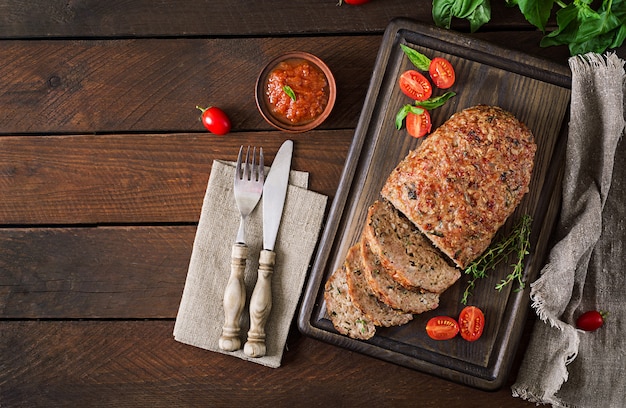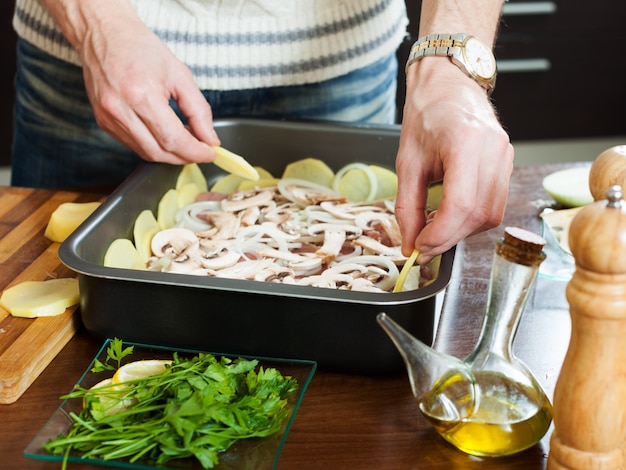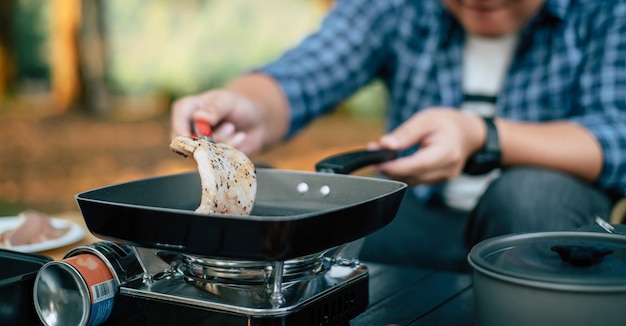You know that feeling, right? When you're craving something delicious, something that's both satisfying and elegant? For me, that's often a perfectly pan-seared tuna steak. The crispy, golden sear on the outside, that tender, melt-in-your-mouth interior, and the burst of flavour - it's a culinary experience that never fails to impress.
Now, I'm not a professional chef, but I've spent years in the kitchen experimenting with different cooking techniques. I've had my share of tuna mishaps, those dry, rubbery disasters that make you question your culinary abilities. But I've also discovered the magic of pan-searing tuna, and I want to share those secrets with you.
This guide is your roadmap to achieving tuna perfection. We'll go through everything, from choosing the right tuna to mastering the perfect sear, and I'll share some of my favourite accompaniments to elevate your dish. So grab your favourite pan, a sharp knife, and a pinch of enthusiasm – let's get cooking!
(Part 1) The Tuna: A Star in the Making

Choosing the Right Tuna
The first step in this culinary adventure is selecting the right tuna. Don't just grab any old tuna - take your time, and choose wisely!
- Freshness is Key: Whenever possible, opt for fresh tuna steaks. A good fishmonger or a reputable supermarket will be your best bet. Look for tuna that's got a vibrant, red flesh and a clean, slightly sweet smell. Avoid any tuna that has a strong fishy odour or looks discoloured. That's a sure sign it's not fresh.
- Size Matters: For pan-searing, I recommend tuna steaks that are about 1-1.5 inches thick. This thickness allows for a great sear on the outside while ensuring the interior cooks through without drying out.
- Tuna Variety: There's a world of tuna out there! Yellowfin tuna is a classic choice - it's got a good flavour and a firm texture. Bigeye tuna is a bit richer and oilier, giving a more intense flavour. If you're feeling adventurous, try swordfish - it's got a meaty texture and a slightly sweet taste. Just be mindful of sustainable fishing practices when choosing your tuna.
Prepping Your Tuna Star
Once you've got your tuna, it's time to give it a little TLC before it hits the pan.
- Pat it Dry: Before doing anything else, pat the tuna steak dry with paper towels. This might seem like a small detail, but it's essential for achieving a crispy sear. A damp surface will lead to steaming instead of browning.
- Seasoning Simple: I like to keep things simple when seasoning tuna. Generously season both sides with salt and pepper. You can also add a touch of herbs like thyme or rosemary for extra flavour.
- Rest for Perfection: Let the seasoned tuna steak rest at room temperature for about 15-20 minutes before cooking. This lets the tuna come to room temperature, which helps it cook more evenly.
(Part 2) The Pan-Searing: A Show of Skill

The Pan: Your Culinary Stage
Now, we're getting into the heart of the action. You'll need a good pan, one that can handle high heat and deliver that perfect sear.
My go-to is a cast iron pan. It's a bit of a culinary workhorse, with a history of smoky evenings, sizzling garlic, and the occasional burnt finger. But it's reliable, it holds heat beautifully, and it gives that gorgeous crust to the tuna. If you don't have a cast iron pan, a good stainless steel pan will work well too.
The Heat: The Key to Success
Here's where things get serious. You need high heat! Really high heat! This is the secret to achieving a perfect sear and unlocking those delicious flavours.
The reason behind the high heat is something called the Maillard reaction. It's a chemical magic trick that happens when proteins and sugars are heated. It's responsible for the beautiful brown crust on your tuna, the caramelized edges of your vegetables, and the irresistible aroma of grilled food.
Get your pan scorching hot! For a gas stove, crank up the heat to high. If you're using an electric stove, turn it up to the highest setting. You want the pan to be smoking hot before you even think about adding the tuna.
The Oil: The Lubricant
Once your pan is blazing hot, add a generous amount of oil. I usually use olive oil, but grapeseed oil or avocado oil are also excellent choices because they have higher smoke points.
Don't be afraid to use plenty of oil! You want to create a shimmering pool that will coat the tuna steak and ensure a smooth, even sear.
(Part 3) The Sear: The Moment of Truth

This is it! The moment of truth. The culmination of all our preparation. The time to unleash your inner culinary maestro.
Carefully place the tuna steak into the hot pan. You should hear a satisfying sizzle as the tuna makes contact with the pan.
The Rules of the Sear
Now, listen closely, because here are the golden rules for a perfect sear:
- Don't Touch It! Resist the urge to poke or prod the tuna steak. Let it cook undisturbed for about 2-3 minutes per side. This gives the tuna time to develop a beautiful, even sear.
- Flip it Like it's Hot: Once the first side is nicely browned, carefully flip the tuna steak over using tongs. Again, let it cook undisturbed for another 2-3 minutes.
The Interior: A Matter of Preference
Now, here's where things get personal. You can cook the tuna to your desired level of doneness. It's all about finding your perfect balance.
- Rare: If you like your tuna rare, cook it for about 1 minute per side. The center will be cool and red.
- Medium-Rare: My personal favourite! Cook for about 2 minutes per side. The center will be slightly warm and pink, with a juicy texture.
- Medium: For a more cooked tuna, cook for about 3 minutes per side. The center will be warm and slightly pink.
- Well-Done: If you prefer your tuna well-done, cook for about 4 minutes per side. The center will be warm and fully opaque.
(Part 4) The Rest: A Moment of Patience
After you've achieved your desired level of doneness, remove the tuna steak from the pan and place it on a cutting board. Let it rest for about 5-10 minutes before slicing and serving.
This resting time is crucial. It allows the juices to redistribute throughout the tuna steak, resulting in a more tender, flavorful dish.
(Part 5) The Accompaniments: A Symphony of Flavors
Now, it's time to turn your pan-seared tuna into a full-blown culinary masterpiece. We're going to add those delicious accompaniments that will take your dish to the next level.
The world of tuna accompaniments is vast and exciting. Here are a few of my go-to combinations that never fail to impress.
A Mediterranean Escape
This combination captures the vibrant flavours of the Mediterranean.
- Lemon-Herb Sauce: Whisk together a generous squeeze of lemon juice, a handful of chopped fresh herbs (like parsley, dill, and mint), olive oil, salt, and pepper. Drizzle this tangy, fragrant sauce over the tuna for a burst of freshness.
- Roasted Vegetables: Toss colourful vegetables like bell peppers, zucchini, and cherry tomatoes with olive oil, salt, and pepper. Roast them in a hot oven until they're tender and slightly caramelized. The sweetness of the roasted vegetables complements the rich flavour of the tuna perfectly.
- Crusty Bread: Nothing beats a crusty loaf of bread to soak up the delicious juices and sauces from your tuna.
An Asian Fusion
If you're looking for something a bit more adventurous, try an Asian-inspired twist on your pan-seared tuna.
- Sesame-Ginger Sauce: Mix together sesame oil, soy sauce, grated ginger, honey, and a pinch of red pepper flakes. The sweetness of the honey balances the savory notes of the soy sauce and ginger, creating a harmonious flavour profile.
- Steamed Rice: A bed of fluffy white rice is the perfect companion to the rich flavors of the tuna and sauce.
- Pickled Ginger: Add a tangy punch to your dish with some pickled ginger. The combination of sweet and sour flavors is a delightful contrast to the savory tuna.
A Simple Elegance
Sometimes, less is more. Sometimes, the simplest combinations are the most satisfying.
- Butter Sauce: Melt a knob of butter in a pan and add a squeeze of lemon juice. Spoon this simple but elegant sauce over the tuna steak.
- roasted asparagus: Roast some asparagus until it's tender-crisp and season it with salt and pepper. The earthy flavour of asparagus pairs beautifully with the delicate tuna.
- mashed potatoes: Classic comfort food, mashed potatoes provide a creamy counterpoint to the delicate flavours of the tuna.
(Part 6) The Presentation: A Culinary Work of Art
Now, it's time to present your culinary masterpiece. This is where you showcase the fruits of your labour.
I like to keep things simple and elegant.
- Serving Platter: Use a nice serving platter or plate to showcase your tuna steak.
- Garnish: Add a few finishing touches, like a sprig of fresh herbs or a drizzle of olive oil.
- Side Plates: Serve the accompaniments on separate side plates.
Remember, presentation is key. A beautifully presented dish enhances the dining experience.
(Part 7) The Enjoyment: A Moment of Pure Bliss
Finally, it's time to enjoy the fruits of your labor. Take a deep breath, savor the moment, and dig in.
As you take your first bite, let the flavours dance on your tongue. The delicate sweetness of the tuna, the tangy burst of the lemon, the earthy notes of the roasted vegetables – it's a symphony of flavor that will leave you wanting more.
But don't just eat it – experience it.
(Part 8) The Leftovers: A Culinary Treasure
Let's be honest, sometimes we end up with some leftover tuna. Don't fret! There are plenty of delicious ways to use it up.
- Tuna Salad: Chop the leftover tuna and combine it with mayonnaise, celery, onion, and seasonings. Enjoy it on bread, crackers, or lettuce wraps.
- Tuna Pasta Salad: Combine leftover tuna with cooked pasta, vegetables, and a creamy dressing. It's a perfect lunch or dinner option.
- Tuna Tacos: Warm up some tortillas and fill them with leftover tuna, salsa, and avocado. It's a quick and satisfying meal.
(Part 9) The FAQs: Your Guide to Tuna Triumph
You've got questions? I've got answers.
FAQs
| Question | Answer |
|---|---|
| Can I use frozen tuna for pan-searing? | It's not ideal, but it can be done. Make sure to thaw the tuna thoroughly before cooking. The texture might be slightly different, but the flavor should still be good. |
| How do I know if my tuna is cooked through? | The best way to check is with a meat thermometer. Insert the thermometer into the thickest part of the tuna. The internal temperature should reach 145°F (63°C) for medium-rare. |
| What are some other great accompaniments for pan-seared tuna? | The possibilities are endless! Try grilled pineapple, mango salsa, roasted sweet potatoes, or a creamy avocado sauce. |
| Can I pan-sear tuna steaks in a smaller pan? | Absolutely! Just make sure the pan is big enough to accommodate the tuna steak without overcrowding it. |
| What are some tips for cleaning my cast iron pan after pan-searing? | Clean it while it's still hot! Use a paper towel to wipe away any remaining oil and food particles. Then, wash it with hot water and a little soap. |
Well, there you have it! My guide to perfect pan-seared tuna steaks. Now, go forth and conquer the kitchen.
Happy cooking!
Everyone is watching

Corn on the Cob: The Ultimate Guide to Perfectly Cooked Ears
Healthy MealsAh, corn on the cob. Just the name evokes images of sunny days, barbecues, and that sweet, juicy flavour that ...

Perfect Pork Roast Oven Cooking Time: A Guide to Delicious Results
Healthy MealsThere's something truly satisfying about a perfectly roasted pork. The aroma alone is enough to make your mout...

Ham Cooking Time: How Long to Bake, Smoke, or Boil a Delicious Ham
Healthy MealsAh, ham. It's a classic, isn't it? A real crowd-pleaser, especially around holidays. And when done right, it'...

Scallops: The Ultimate Guide to Perfect Cooking
Healthy MealsAh, scallops. Those delicate, sweet, and utterly delicious morsels of the sea. They hold a special place in my...

Spaghetti Squash: The Ultimate Guide to Cooking and Serving
Healthy MealsRemember that time you saw spaghetti squash at the supermarket, looking all bumpy and strange, and thought, "W...
